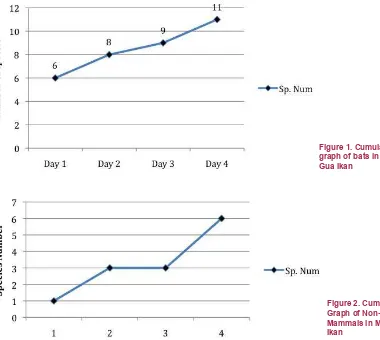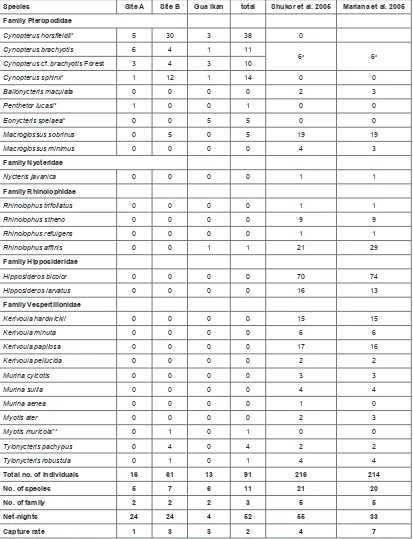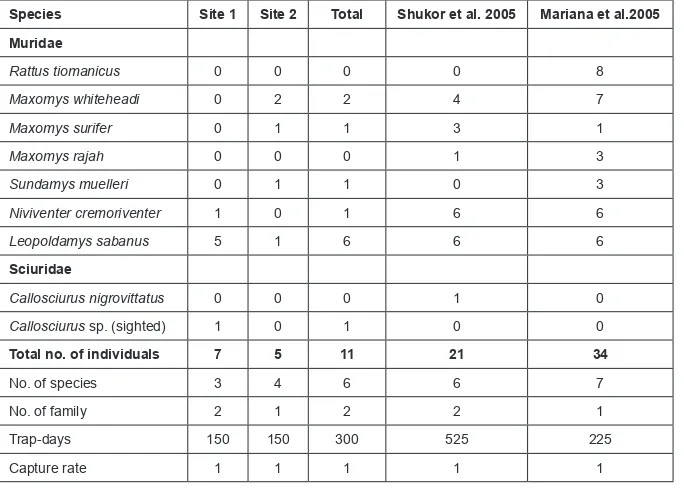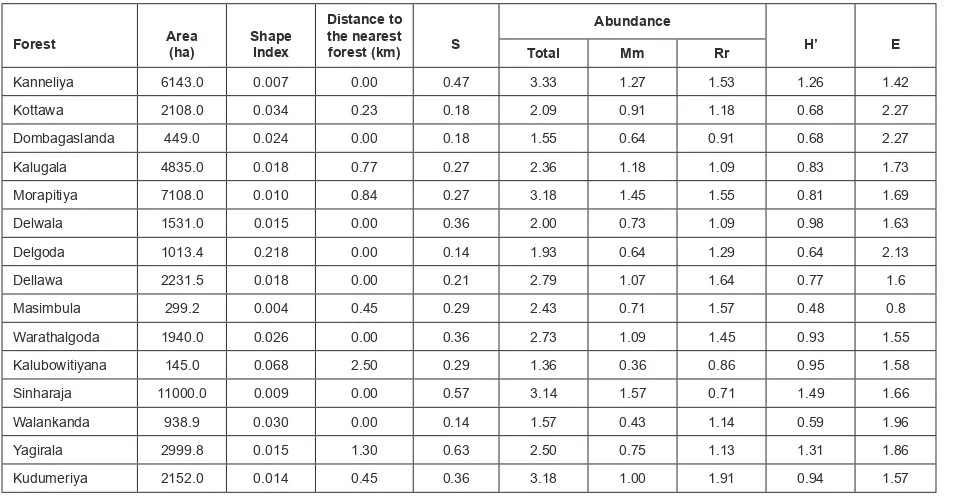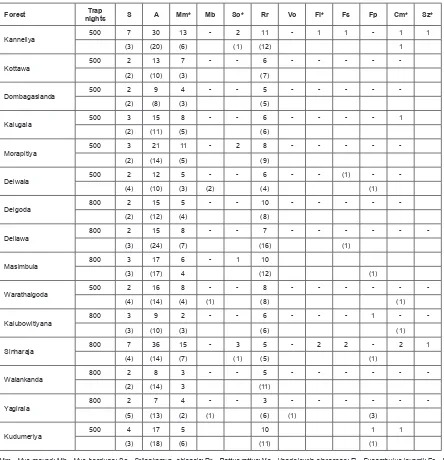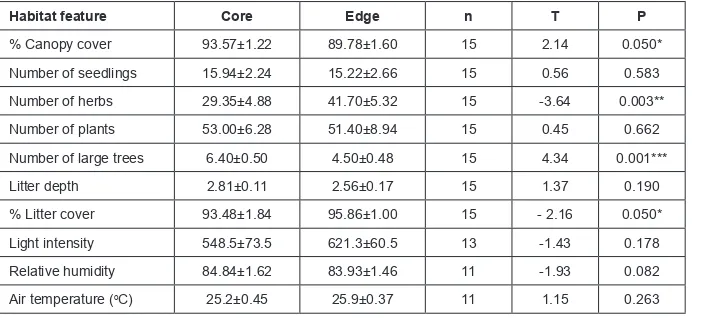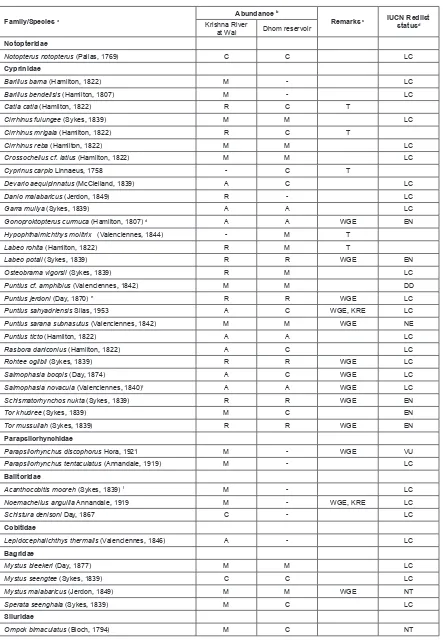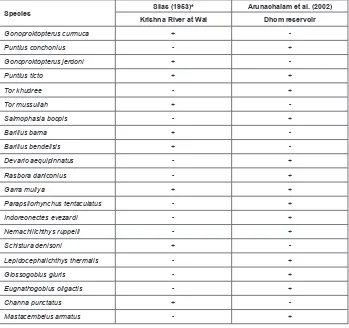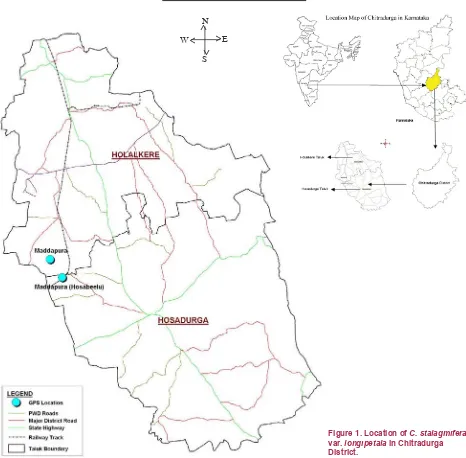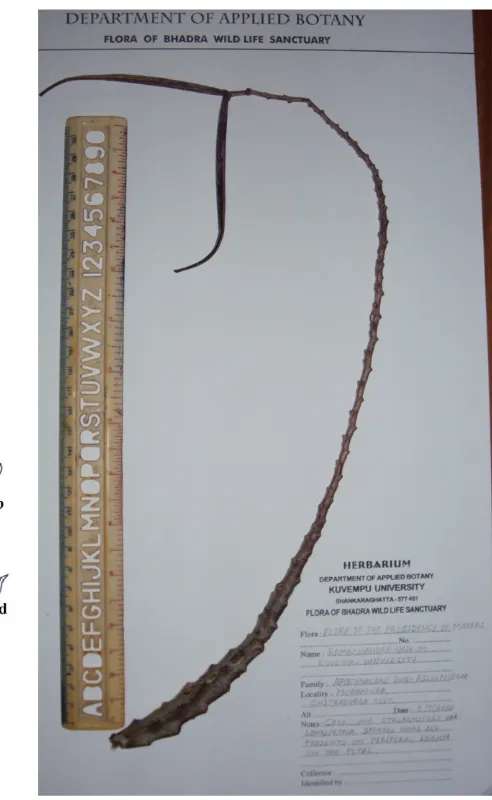June 2012 | Vol. 4 | No. 6 | Pages 2617–2672
Date of Publication 26 June 2012
ISSN 0974-7907 (online) | 0974-7893 (print)
Creative Commons Attribution 3.0 Unported License. JoTT allows unrestricted use of articles in any medium
for non-profit purposes, reproduction and distribution by providing adequate credit to the authors and the
source of publication.
Belosynapsis vivipara
© Shrinath Kavade © Shrinath Kavade
EDITORS
FOunDER & ChIEF EDITOR
Dr. Sanjay Molur, Coimbatore, India
ManagIng EDITOR
Mr. B. Ravichandran, Coimbatore, India
aSSOCIaTE EDITORS
Dr. B.A. Daniel, Coimbatore, India Dr. Manju Siliwal, Dehra Dun, India Dr. Meena Venkataraman, Mumbai, India Ms. Priyanka Iyer, Coimbatore, India
EDITORIal aDvISORS
Ms. Sally Walker, Coimbatore, India Dr. Robert C. Lacy, Minnesota, USA Dr. Russel Mittermeier, Virginia, USA Dr. Thomas Husband, Rhode Island, USA Dr. Jacob V. Cheeran, Thrissur, India Prof. Dr. Mewa Singh, Mysuru, India Dr. Ulrich Streicher, Oudomsouk, Laos Mr. Stephen D. Nash, Stony Brook, USA Dr. Fred Pluthero, Toronto, Canada Dr. Martin Fisher, Cambridge, UK Dr. Ulf Gärdenfors, Uppsala, Sweden Dr. John Fellowes, Hong Kong Dr. Philip S. Miller, Minnesota, USA Prof. Dr. Mirco Solé, Brazil
EDITORIal BOaRD / SuBjECT EDITORS Dr. M. Zornitza Aguilar, Ecuador Prof. Wasim Ahmad, Aligarh, India Dr. Sanit Aksornkoae, Bangkok, Thailand. Dr. Giovanni Amori, Rome, Italy
Dr. István Andrássy, Budapest, Hungary Dr. Deepak Apte, Mumbai, India
Dr. M. Arunachalam, Alwarkurichi, India Dr. Aziz Aslan, Antalya, Turkey
Dr. A.K. Asthana, Lucknow, India Prof. R.K. Avasthi, Rohtak, India Dr. N.P. Balakrishnan, Coimbatore, India Dr. Hari Balasubramanian, Arlington, USA Dr. Maan Barua, Oxford OX , UK
Dr. Aaron M. Bauer, Villanova, USA Dr. Gopalakrishna K. Bhat, Udupi, India Dr. S. Bhupathy, Coimbatore, India Dr. Anwar L. Bilgrami, New Jersey, USA Dr. Renee M. Borges, Bengaluru, India Dr. Gill Braulik, Fife, UK
Dr. Prem B. Budha, Kathmandu, Nepal
Mr. Ashok Captain, Pune, India
Dr. Cleofas R. Cervancia, Laguna , Philippines Dr. Apurba Chakraborty, Guwahati, India Dr. Kailash Chandra, Jabalpur, India
Dr. Anwaruddin Choudhury, Guwahati, India Dr. Richard Thomas Corlett, Singapore Dr. Gabor Csorba, Budapest, Hungary Dr. Paula E. Cushing, Denver, USA
Dr. Neelesh Naresh Dahanukar, Pune, India Dr. R.J. Ranjit Daniels, Chennai, India Dr. A.K. Das, Kolkata, India
Dr. Indraneil Das, Sarawak, Malaysia Dr. Rema Devi, Chennai, India Dr. Nishith Dharaiya, Patan, India
Dr. Ansie Dippenaar-Schoeman, Queenswood, South Africa
Dr. William Dundon, Legnaro, Italy Dr. Gregory D. Edgecombe, London, UK Dr. J.L. Ellis, Bengaluru, India
Dr. Susie Ellis, Florida, USA
Dr. Zdenek Faltynek Fric, Czech Republic Dr. Carl Ferraris,NE Couch St., Portland Dr. R. Ganesan, Bengaluru, India
Dr. Hemant Ghate, Pune, India Dr. Dipankar Ghose, New Delhi, India Dr. Gary A.P. Gibson, Ontario, USA Dr. M. Gobi, Madurai, India
Dr. Stephan Gollasch, Hamburg, Germany Dr. Michael J.B. Green, Norwich, UK Dr. K. Gunathilagaraj, Coimbatore, India Dr. K.V. Gururaja, Bengaluru, India Dr. Mark S. Harvey,Welshpool, Australia Dr. Magdi S. A. El Hawagry, Giza, Egypt Dr. Mohammad Hayat, Aligarh, India Prof. Harold F. Heatwole, Raleigh, USA
Dr. V.B. Hosagoudar, Thiruvananthapuram, India Prof. Fritz Huchermeyer, Onderstepoort, South Africa Dr. V. Irudayaraj, Tirunelveli, India
Dr. Rajah Jayapal, Bengaluru, India Dr. Weihong Ji, Auckland, New Zealand Prof. R. Jindal, Chandigarh, India Dr. Pierre Jolivet, Bd Soult, France Dr. Rajiv S. Kalsi, Haryana, India Dr. Rahul Kaul, Noida,India
Dr. Werner Kaumanns, Eschenweg, Germany Dr. Paul Pearce-Kelly,Regent’s Park, UK Dr. P.B. Khare, Lucknow, India
Dr. Vinod Khanna, Dehra Dun, India Dr. Cecilia Kierulff, São Paulo, Brazil Dr. Ignacy Kitowski, Lublin, Poland
j
OuRnal
OF
T
hREaTEnED
T
axa
Published by Typeset and printed at
Wildlife Information Liaison Development Society Zoo Outreach Organisation
96, Kumudham Nagar, Vilankurichi Road, Coimbatore 641035, Tamil Nadu, India Ph: +91422 2665298, 2665101, 2665450; Fax: +91422 2665472
Email: [email protected], [email protected] Website: www.threatenedtaxa.org
JoTT COMMunICaTIOn 4(6): 2617–2628
Species diversity of small mammals at Gunung Stong
State Park, Kelantan, Malaysia
Vijaya Kumaran Jayaraj 1, Nurul Farah Diyana Ahmad Tahir 2, Noor Amirah Udin 3, Noor Farahin Kamarul Baharin 4, Siti Katijah Ismail 5 & Siti Noor Azwa Zakaria 6
1,2,3,4,5,6 Faculty of Agro Industry and Natural Resources, Universiti Malaysia Kelantan, Jeli Campus Locked bag No. 100, 17600 Jeli, Kelantan, Malaysia
Email: 1 [email protected] (corresponding author), 2 [email protected], 3 [email protected], 4 [email protected], 5 [email protected], 6 [email protected]
OPEN ACCESS | FREE DOWNLOAD
Abstract: A recent small mammal survey was conducted in Gunung Stong State Park. Standard mist nets, harp traps and cage traps were used to document diversity of small mammals in this new protected area. This study reports five new distributional records of bats in Gunung Stong State Park and a first record of Myotis muricola in Kelantan. The study also shows that Gunung Stong State Park is one of the three areas in Peninsular Malaysia where all four Cynopterus species that can be found in Peninsular Malaysia coexist. This protected area also has Maxomys rajah, M. whiteheadi and Niviventer cremoriventer which are currently listed as Vulnerable, highlighting this location as an important conservation area for small mammals. Continuous surveys are needed as information of small mammal diversity in Kelantan is still scarce, and this study is a part of a series of small mammal surveys that have been carried out in Kelantan.
Keywords: Gunung Stong State Park, Kelantan, new record, small mammals, species diversity.
IntroductIon
Gunung Stong State Park, Malaysia which covers an area of 21,950ha, is situated north west of Kelantan in the district of Kuala Krai (Maseri & Mohd-Ros 2005). This state park is strategically positioned as part of a large forest block that includes the Titiwangsa Range, the Belum-Temenggor and the Ulu Muda forests in Malaysia, and connects with the stretch of forests in Hala Bala Wildlife Sanctuary and the Bang Lang National Park in southern Thailand (Maseri & Mohd-Ros 2005). This positioning, coupled with the buffering effect of various forests reserves around the area, is most suitable for fauna conservation as many iconic large mammals such as tigers, elephants, deer and leopards are found
there (Zafir et al. 2005).
Gunung Stong State Park is also a good area for ecotourism. Its center of attraction is the Jelawang waterfall which is hailed as the highest waterfall in Southeast Asia (Yusoff et al. 2005). This state park also
has iconic flora and fauna, that appeal to nature photographers, such as
hornbills, banded leaf monkeys, colugo, the endemic Fan Palm Licuda stongensis, the endemic Bamboo Holtummochloa pubescens and Rafflesia
kerrii (Latiff & Faridah-Hanum 2005). Together with several mountain peaks such as Gunung Ayam, Gunung Tera and Gunung Stong, this place is suitable for a variety of recreational activities and has been listed in the 2006 Malaysian National Economic Plan as one of the top 10 special places for ecotourism.
According to Bourliere (1975), small mammals have adult weights
Date of publication (online): 26 June 2012 Date of publication (print): 26 June 2012 ISSN 0974-7907 (online) | 0974-7893 (print)
Editor: Giovanni Amori
Citation: Jayaraj, V.K., N.F.D.A. Tahir, N.A.Udin, N.F.K. Baharin, S.K. Ismail & S.N.A. Zakaria (2012). Species diversity of small mammals at Gunung Stong State Park, Kelantan, Malaysia.
Journal of Threatened Taxa 4(6): 2617–2628.
Copyright: © Vijaya Kumaran Jayaraj, Nurul Farah Diyana Ahmad Tahir, Noor Amirah Udin, Noor Farahin Kamarul Baharin, Siti Katijah Ismail & Siti Noor Azwa Zakaria 2012. Creative Commons Attribution 3.0 Unported License. JoTT allows unrestricted use of this article in any
medium for non-profit purposes, reproduction
and distribution by providing adequate credit to the authors and the source of publication.
Author Contribution: VKJ is the corresponding author of this paper. He provided the funding,
the tabulation of results.
For Author Details and Acknowledgments
See end of this article.
ranging from 2gm to 5kg. The majority of species in this category are from the high diversity orders Rodentia and Chiroptera, and Lagomorpha, Insectivora and Scandentia are also in this group. The importance of Rodentia and Chiroptera in the ecology of the tropical rainforest in Southeast Asia is recognized, yet the small mammals of Kelantan are not well known, with records of surveys from EIA surveys on certain development projects such as the Pergau, Lebir and Negiri Dam Project (see Pue & Latiff 2005) and
surveys conducted by Zafir et al. (2005), Shukor et al.
(2005) and Mariana et al. (2005). The objective of this study was to survey the diversity and abundance of small mammals in Gunung Stong State Park and add further information on the biodiversity of small mammals in Kelantan, Malaysia.
MaterIals and Methods
The main sampling areas of this study were the Gunung Stong State Park headquarters and Gua Ikan (Image 1). Two trails near the park headquaters were
chosen as sampling stations for bats. The first sampling
station was Stong Trail 1 (5020.352’N & 101058.503’E, elevation 100–200 m) and the second sampling station was Stong Trail 3 (5020.353’N & 101058.505’E, 100–
200 m). The vegetation at the first sampling station
was hill vegetation with some bamboo plots, and the second sampling station was in the vicinity of the forest ecotone. A total of 10 mist nets and two harp-traps were used to capture bats. These nets and traps were
placed in presumed flyways of bats at the sampling
stations for four consecutive nights (2–4 March 2011). We also set up four additional nets near in Gua Ikan (05021.268’N & 10201.5483’E, 97m) which are limestone caves that are found near the forest reserve. For non-volant small mammals, two sites were
Small mammals of Gunung Stong V.K. Jayaraj et al.
chosen in the vicinity of the park headquarters (5020.352’N & 101058.503’E, 100–200 m) and Gua Ikan (5021.268’N & 10201.5483’E, 97m). The vegetation at the sampling stations were: site A) hill vegetation with some bamboo plots and river vegetation (park headquarters), and site B) limestone area (Gua Ikan). Non-volant small mammals were captured using cage traps and all traps were placed
on the ground to target forest floor small mammals.
A total of 100 cage traps baited with pineapple were used for this purpose and all traps were placed for four consecutive days (2–4 March 2011).
Captured animals were identified using keys from
Francis (2008), and standard measurements were recorded. The diversity of small mammals for this survey was presented as list of species recorded and abundance was characterized by the capture rate of each species during this survey.
results
The cumulative species graph over days for bats is shown in Fig. 1. The graph is yet to reach an asymptotic level indicating that in-terms of sampling, there may still be species that are yet to be recorded. This also indicates that the netting effort of 52 net-nights was not adequate to sample the total chiroptera community in Kelantan. Table 1 shows the list of species caught, net-nights and capture rate of bats in this study and further comparison with the data from Mariana et al. (2005) and Shukor et al. (2005). This survey recorded 11 species of bats and the highest number of individuals caught was Cynopterus horsfieldii, followed by C. sphinx and the lowest capture rate were from Rhinolophus affinis, Tylonycteris robustula and
Myotis muricola.
The species graph over days for non-volant mammals is shown in Fig. 2. The graph reached an asymptotic level on the 2nd day – 3rd day but the number of species trapped increased on the 4th day of sampling indicating that the total trapping effort was
Figure 1. Cumulative frequency graph of bats in Mount Stong and Gua Ikan
not adequate to document non-volant small mammals
diversity on the forest floor in the sampling stations.
We recorded a total of six species of non-volant small mammals in this study with the highest number of individuals caught were Leopoldamys sabanus (six
individuals) followed by Maxomys whiteheadi (two individuals).
species accounts
Cynopterus brachyotis (Müller, 1838): This
Species Site A Site B Gua Ikan total Shukor et al. 2005 Mariana et al. 2005
Family Pteropodidae
Cynopterus horsfieldii* 5 30 3 38 0
Cynopterus brachyotis 6 4 1 11
6a 6a
Cynopterus cf. brachyotis Forest 3 4 3 10
Cynopterus sphinx* 1 12 1 14 0 0
Balionycteris maculata 0 0 0 0 2 3
Penthetor lucasi* 1 0 0 1 0 0
Eonycteris spelaea* 0 0 5 5 0 0
Macroglossus sobrinus 0 5 0 5 19 19
Macroglossus minimus 0 0 0 0 4 3
Family Nycteridae
Nycteris javanica 0 0 0 0 1 1
Family Rhinolophidae
Rhinolophus trifoliatus 0 0 0 0 1 1
Rhinolophus stheno 0 0 0 0 9 9
Rhinolophus refulgens 0 0 0 0 1 1
Rhinolophus affinis 0 0 1 1 21 29
Family Hipposideridae
Hipposideros bicolor 0 0 0 0 70 74
Hipposideros larvatus 0 0 0 0 16 13
Family Vespertilionidae
Kerivoula hardwickii 0 0 0 0 15 15
Kerivoula minuta 0 0 0 0 6 6
Kerivoula papilosa 0 0 0 0 17 16
Kerivoula pellucida 0 0 0 0 2 2
Murina cylcotis 0 0 0 0 3 3
Murina suilla 0 0 0 0 4 4
Murina aenea 0 0 0 0 1 0
Myotis ater 0 0 0 0 2 3
Myotis muricola** 0 1 0 1 0 0
Tylonycteris pachypus 0 4 0 4 2 2
Tylonycteris robustula 0 1 0 1 4 4
Total no. of individuals 16 61 13 91 216 214
No. of species 5 7 6 11 21 20
No. of family 2 2 2 3 5 5
Net-nights 24 24 4 52 55 33
Capture rate 1 3 3 2 4 7
Table 1. List of species caught, net nights and capture rate of bats in this study
* - new record at Gunung Stong State Park; ** - New record for Kelantan based on Pue & Latiff (2005), Mohd Zafir et al. (2005) and Mariana et al. (2005);
Small mammals of Gunung Stong V.K. Jayaraj et al.
species has been recorded in open areas and agricultural plots in southern Thailand, Peninsular Malaysia and Borneo (Abdullah 2003; Abdullah et al.1997a,b, 2000; Anwarali et al. 2007; Hall et al. 2002, 2004; Karim et al. 2004; Azlan et al. 2005; Jayaraj et al. 2011, 2012). In Borneo C. brachyotis is one of the most successful and dominant fruit bat in terms of capture rate and distribution. We netted this species near the forest fringe and near a small stream. This species is listed as Least Concern in the IUCN Red List of Threatened Species (Csorba et al. 2008) and Red List of Mammals for Peninsular Malaysia (DWNP 2010).
There has been ongoing research on the presence of several distinct lineages in this species and in southern Thailand, Peninsular Malaysia and Borneo a smaller form tentatively assigned as C. cf. brachyotis Forest
has been identified (Abdullah 2003; Campbell et al.
2004, 2006, 2007; Jayaraj 2009; Fong 2011; Jayaraj et al. 2012). We took the liberty of separating the new form C. cf. brachyotis Forest as a separate account for future reference using methods described by Jayaraj
et al. (2012).
Cynopterus cf. brachyotis Forest: This undescribed species has been known to occur in primary forests and old secondary forests in contrast with the habitat of C. brachyotis (Abdullah 2003). We caught C. cf.
brachyotis Forest in the forest fringes in the same nets that netted C. brachyotis, indicating that these two species although occurs in contrasting habitats but may meet at forest fringes. This undescribed species (see Simmons 2005) is not listed in IUCN’s Red List of Threatened Species (2008) and Red List of Mammals for Peninsular Malaysia (DWNP 2010).
Cynopterus horsfieldii Gray, 1843: This is a new
record for Gunung Stong State Park. This species is known to be a forest dwelling Cynopterus, commonly caught at the ecotones and may occur sympatric with C. cf. brachyotis Forest but there are records of this species netted in oil palm plantations and in Pulau Tioman (Lim et al. 1999). The capture rate of this species was the highest in this study, which was highly in contrast when compared with trapping
Image 2. Female C. horsfieldii (left) with less prominent sagittal crest versus male C. horsfieldii with prominent sagittal crest (A)
results in similar vegetations in Borneo (see Jayaraj et al. 2011) whereas in Pahang the capture rate of this species is similar with C. brachyotis (see Lim et al. 2008). Individuals of this species were caught in all three forms of habitat (ecotones, hill forest and limestone areas). Sexual dimorphism of skulls was apparent, where in male skulls have more prominent sagittal crest compared to female skulls (Image 2). Storz et al. (2000) and they found out that this species exhibits a polygynous mating system, with males having varying harem size from six to 13 females. Lim et al. (2008) suggested that the distribution pattern of C. sphinx should be investigated as little is known about the current distribution of this species in Malaysia. Clinal variation in terms of size of this species was discussed by Storz et al. (2001) and our observations (unpublished data) indicate that C. sphinx is not highly adaptable in Peninsular Malaysia incongruent with observations of Bates et al. (2008b). Although widespread the abundance of this species is determined by the type of vegetation sampled (Campbell et al. 2006). In Gunung Stong State Park the forearm length of this species was 74.52±3.87 mm and this species was netted in the hill vegetation and near bamboo plots beside the forest fringe. Struebig et
al. (2005) netted this species near fruiting figs trees and
this is commonly observed across Peninsular Malaysia with other Cynopterans. This species is listed as Least Concern in the IUCN Red List of Threatened Species (Bates et al. 2008b) and Red List of Mammals for Peninsular Malaysia (DWNP 2010).
Penthetor lucasi (dobson, 1880): This is a new record for Gunung Stong State Park. Only one individual was caught near the forest fringe throughout the survey. This cave dwelling species normally roosts in large numbers and may have a population size up to 70,845 individuals [mark recapture model estimates in Wind Cave Nature Reserve Sarawak, Malaysia by Barapoi (2004)]. A recent study by Rahman & Abdullah (2010) indicated that there are two or more morphologically distinct forms of P. lucasi from
Eonycteris spelaea (dobson, 1871): This is a new
record for Gunung Stong State Park. Five individuals of this species were caught near the limestone area throughout the survey. Daytime survey in the cave revealed that this species was abundant in the Gua Ikan. Previously, this species was netted at Gua Musang, Kelantan (Shabrina 1991). Mariana et al. (2005) and Shukor et al. (2005) did not record this species in their survey most probably because their nets were not placed near the cave. Anwarali et al. (2008) observed that individuals from Peninsular Malaysia versus Borneo had a genetic distance of 1%. This species is listed as Least Concern in the IUCN Red List of Threatened Species (Francis et al. 2008) and Red List of Mammals for Peninsular Malaysia (DWNP 2010).
Macroglossus sobrinus K. andersen, 1911: This
species is common in many forest types in Malaysia
but has been associated with flowering banana plots and mangrove areas. We collected five individuals
of M. sobrinus near the river and similarly Shukor et al. (2005) and Mariana et al. (2005) collected 19 individuals of this species in their expeditions. This species is listed as Least Concern in the IUCN Red List of Threatened Species (Hutson et al. 2008).
Rhinolophus affinis Horsfield, 1823: Only one
individual was caught in this survey near Gua Ikan. This highly adaptable and common species can be found in most protected areas in Malaysia and are generally abundant in most sites sampled. However, Lim et al. (2008) and Kingston et al. (2008) stated that this species is a common under-storey forest
bat that is confined to caves. Shukor et al. (2005)
collected 21 individuals of this species while Mariana et al. (2005) collected 29 individuals indicating high abundance of this species in Gunung Stong State Park. Approximately 4% in cyt-bgenetic distance observed between Bornean individuals and a single individual from Thailand in Anwarali et al. (2008) and this may
have some significance in this study as this individual
Small mammals of Gunung Stong V.K. Jayaraj et al.
Threatened Species (Walston et al. 2008) and Red List of Mammals for Peninsular Malaysia (DWNP 2010).
Myotis muricola (Gray, 1846): This is a new record for Gunung Stong State Park and Kelantan. We netted this species near the bamboo plots but this species is generally netted in open areas, heath forest, peat swamps, streams and rivers near forest, and agricultural plots (Struebig et al. 2006; Francis 2008). The Red List of Mammals for Peninsular Malaysia (DWNP 2010) indicates that this species is widely distributed in peninsular Malaysia. Francis (2008) mentioned that this species maybe a complex species based on genetic analyses but diagnostic characters and appropriate names have yet to be assigned (see Anwarali et al. 2008). Only one individual was recorded throughout the survey and this species is listed as Least Concern in the IUCN Red List of Threatened Species (Bates et al. 2008d) and Red List of Mammals for Peninsular Malaysia (DWNP 2010).
Tylonycteris pachypus (temminck, 1840): This
species was netted near bamboo plots and a total of four individuals were collected throughout the survey. Shukor et al. (2005) collected only two individuals in their survey but we believe that this species maybe more abundant in Gunung Stong State Park based on the presence of many bamboo plots and observations of slit in the internodes of the bamboos. This species is listed as Least Concern in the IUCN Red List of Threatened Species (Bates et al. 2008e) and Red List of Mammals for Peninsular Malaysia (DWNP 2010).
Tylonycteris robustula thomas, 1915: This is a species of bat associated with bamboos (Anwarali et al 2008; Francis 2008) and is a sister species with T. pachypus (Francis 2008). We collected only one individual of T. robustula in this survey, whereas Mariana et al. (2005) and Shukor et al. (2005) collected four individuals in their surveys. Similarly this species was netted in the same net as T. pachypus, reinforcing the idea that this species does share roosting sites roost hole. This species is listed as Least Concern in the IUCN Red List of Threatened Species (Bates et Khaeng Wildlife Sanctuary, central Thailand (Walker & Rabinowitz 1992). M. surifer and M. rajah have rarely been caught in the same area but Shukor et al. (2005) collected one M. rajah in this state park, indicating that both species may co-occur in the same
area but this needs further confirmation. This species is listed as Least Concern in the IUCN Red List of Threatened Species (Aplin et al. 2008a) and Red List of Mammals for Peninsular Malaysia (DWNP 2010).
Maxomys whiteheadi (thomas, 1894): We trapped
two individuals of this species near Gua Ikan (limestone area) but Francis (2008) stated that generally, this species can be found in tall and old secondary forests and occasionally encroaching disturbed areas in the vicinity of these forests. Wilson et al. (2006) trapped this species in an acacia plantation and a fragmented forest in Borneo. There was also a record of this species occurring in mangrove swamp and secondary forest at Kuala Selangor State Park (Chuluun et al. 2005). This species is listed as Vulnerable in the IUCN Red List of Threatened Species (Aplin et al. 2008b) due to
significant population decline for the past 10 years but
is listed as Least Concern in the Red List of Mammals for Peninsular Malaysia (DWNP 2010).
Sundamys muelleri (Jentink, 1879): This species
has a wide distribution and was normally caught near rivers (Francis 2008). Incidentally, this big rodent was caught in the limestone area of Gua Ikan where there
is a river flowing into the cave. Previously this species
was caught by Lim (1970) at Sungai Durian Forest Reserve and Mariana et al. (2005) in Gunung Stong State Park. In Borneo this species was caught on the ground or low trees (Wilson et al. 2006). Zakaria et al. (2011) found that this species can survive in disturbed habitats. Ruedas et al. (2008a) assigned the status Least Concern for this species in the IUCN Red List of Threatened Species which was congruent with the Red List of Mammals for Peninsular Malaysia (DWNP 2010).
Niviventer cremoriventer (Miller, 1900): Only one
forests, forest area and lightly wooded areas (Francis 2008). Lim et al. (2008) trapped this species in a disturbed secondary forest at Lakum Forest Reserve, Pahang. In Mount Nuang Hulu Langat, this species has been recorded right up to 1350m asl (Shukor et al. 2001; Batin et al. 2002) and Francis (2008) mentioned that this species can be found up to 1900 m asl. This species is listed as Vulnerable in the IUCN Red List
of Threatened Species due to significant population
decline for the past 10 years (Ruedas et al. 2008b) and is listed as Least Concern in the Red List of Mammals for Peninsular Malaysia (DWNP 2010).
Leopoldamys sabanus (thomas, 1887): We
collected a total of six individuals from both trapping sites, dominating non-volant small mammal captures in this study. This species is common in many types of forests in Malaysia and is threatened by clearing of forests (Lim et al. 2008). Individuals of this species were found to be highly infested with ectoparasites and previously Mariana et al. (2005) recorded ticks, Mesostigmatid mites and chiggers on individuals trapped in this same area. It is listed as Least Concern in the IUCN Red List of Threatened Species (Lunde et al. 2008) and Red List of Mammals for Peninsular Malaysia (DWNP 2010).
dIscussIon
This survey recorded 11 species of bats and six species of non-volant small mammals with one new record for Kelantan (Myotis muricola) and four additional distributional records for Gunung Stong State Park (Cynopterus horsfieldii, C. sphinx and
Penthetor lucasi). Bats from the family Pteropodidae dominated the captures as compared to Shukor et al. (2005) and Mariana et al. (2005) who recorded more insectivorous bats. Leopoldamys sabanus (six individuals) dominated the captures for non-volant small mammals followed by Maxomys whiteheadi
(two individuals), while the remaining species (M.
surifer, S. muelleri N. cremoriventer and Callosciurus
sp.) recorded only one individual each. This in-turn increased the total number of small mammals known to occur in Gunung Stong State Park from 28 species to 35 species.
The sampling effort for this survey was not adequate in documenting total chiropteran community at Gunung Stong State Park as the graph is yet to reach and asymptotic level. In Kuala Lompat, Krau Wildlife Reserve, a total of 837 harp-trap nights and 1573 net hours (786 hours for ground nets, 606 hours for stacked nets, 147 hours for canopy nets and 34 hours for river nets) were needed to document total insectivorous bat diversity (Kingston et al. 2003). Hall et al. (2004)
Table 2. List of species caught, net nights and capture rate of non-volant small mammals in this study
Species Site 1 Site 2 Total Shukor et al. 2005 Mariana et al.2005
Muridae
Rattus tiomanicus 0 0 0 0 8
Maxomys whiteheadi 0 2 2 4 7
Maxomys surifer 0 1 1 3 1
Maxomys rajah 0 0 0 1 3
Sundamys muelleri 0 1 1 0 3
Niviventer cremoriventer 1 0 1 6 6
Leopoldamys sabanus 5 1 6 6 6
Sciuridae
Callosciurus nigrovittatus 0 0 0 1 0
Callosciurus sp. (sighted) 1 0 1 0 0
Total no. of individuals 7 5 11 21 34
No. of species 3 4 6 6 7
No. of family 2 1 2 2 1
Trap-days 150 150 300 525 225
Small mammals of Gunung Stong V.K. Jayaraj et al.
showed that generally a total effort of 30 net nights was needed to document total fruit bat composition in most areas in southern Thailand, Peninsular Malaysia and Borneo. In this study, the 54 net nights were not adequate in documenting total chiropteran fauna and to compensate this inadequacy, further surveys can be done on a long term basis.
The low trapping rate of harp traps in this study (averaging one individual per night) contributed to the overall low diversity of insect bats captured in this study. Nonetheless our positioning of the harp traps near the forest edge and beside the river may not be effective if the bats do not use the presumed
flyways. The low capture rate of non-volant small
mammals and the absence of treeshrews and squirrels may be caused by the choice of bait used and trap placement in this study. Previous studies on non-volant small mammals do indicate bait selection by small mammals, as Bernard (2003) mentioned that the local banana variety ‘pisang emas’ (Musa acuminata) generally produces the best capture rate. In this study, we used pineapples as bait and the traps were placed
on the forest floor which may be selective for trapping
rats and treeshrews.
The importance of Gunung Stong State Park for conservation of small mammals is yet to be explored
but this recent survey revealed some major findings;
First, Gunung Stong State Park is the second known protected area in Malaysia where all four species of
Cynopterus that can be found in Peninsular Malaysia (C.
brachyotis, C. cf. brachyotis Forest, C. horsfieldii and
sphinx) co-exist. Previous records of such occurrences in Malaysia were only in Perlis State Park and Taiping, Perak (Campbell et al. 2004, 2006). Sungai Dusun may be another area where all four species co-exist
but this needs to be confirmed (Abdullah 2003; Hall et
al. 2004). Other records of such observations include Thaleban National Park, Thailand (Abdullah 2003; Hall et al. 2004; Abdullah et al. 2007). Abdullah et al. (2007) stated that having three species of Cynopterus
netted in the same area was unusual, and they relate their observation way back in 1997 as due to lack of resource partitioning, diet overlap, or similar roosting,
emergence time and flight behavior of the species.
The results of this study show that all four species of Cynopterus meet at the ecotones (based on netting results) and such area may be the place where lack of space partitioning between these congenerics occur.
The habitat use of these four species can also be divided into open areas and forested areas, thus we speculate that the existence of such areas together with the ecotones in the vicinity and in Gunung Stong State Park may contribute to the conservation of these fruit bats. Second, this area also recorded three species of Maxomys, with M. rajah and M. whiteheadi listed as Vulnerable in the IUCN Red List of Threatened Species (Aplin et al. 2008 a,b). N. cremoriventer also joins the list of Vulnerable species that can be found in this protected area making Gunung Stong State Park an important area for the conservation of these rodents in peninsular Malaysia. These animals are primarily forest dependent species and are not found outside of forested areas (Aplin et al. 2008a,b; Ruedas et al. 2008b) and are threatened by clearing of forests (Lim et al. 2008), thus protected areas are the only areas
where significant conservation planning and effort can
be put in place.
The conservation of bats and small mammals are generally overlooked in many protected area management plans in this country except enigmatic
species such as the large flying fox Pteropus vampyrus
Department of Zoology and Entomology, The University of & Firmansyah (1997b). Abundance, diversity and distributional records of bats in disturbed habitats in Kalimantan Barat, Indonesia. Sarawak Museum Journal 51(72): 75–84. Biodiversity Conservation in the New Millenium. Yayasan Sabah, Kota Kinabalu.
Abdullah, M.T., P. Jusanit, P.W.H. Di, M.Z. Ariffin & L.S. Hall (2007). Observations on bats in three national parks in Thailand. Tiger paper 34(4): 5–10.
anwarali, F.a.K., s.n. sazali, V.K. Jayaraj, s. aban, K.M. Zaini, B. Ketol, J.J.r. ryan, a.M. Julaihi, l.s. hall
& M.T. Abdullah (2007). Survey of bats in the tropical lowland dipterocarp forest of Bako National Park, Sarawak, Malaysian Borneo. Sarawak Museum Journal 63(84): 267– 300.
anwarali, F.a.K., V.J. swier, s. solari, P.a. larsen, B. Ketol, W. Marni, s. ellagupillay, M. lakim, M.t. abdullah, & r.J. Baker (2008). Using genetics and morphology to examine species diversity of Old World bats: report of a recent collection from Malaysia. Occasional Papers,
Museum of Texas Tech University 281: 1–28.
Aplin, K., D. Lunde & G. Musser (2008a).Maxomys surifer. In: IUCN 2011. IUCN Red List of Threatened Species. Version 2011.1. <www.iucnredlist.org>. Downloaded on 30 October 2011.
Aplin, K., D. Lunde, & L. Ruedas (2008b). Maxomys whiteheadi. In: IUCN 2011. IUCN Red List of Threatened Species. Version 2011.1. <www.iucnredlist.org>. Downloaded on 30 October 2011.
Azlan, J.M., J. Neuchlos & M.T. Abdullah (2005). Diversity of chiropterans in limestone forest area, Bau, Sarawak. Malaysian Applied Biology 34(1): 59 - 64.
Barapoi, I.P. (2004). Population size estimation of Penthetor lucasi in Wind Cave, Bau, Sarawak. BSc Thesis. Universiti Malaysia Sarawak, Kota Samarahan, Sarawak.
Bates, P., C. Francis, M.Gumal & S. Bumrungsri (2008a).
Cynopterus horsfieldii. In: IUCN (2011). IUCN Red List of Threatened Species. Version 2011.1. <www.iucnredlist. org>. Downloaded on 30 October 2011.
Bates, P., S. Bumrungsri, S. Molur & C. Srinivasulu (2008b).
Cynopterus sphinx. In: IUCN 2011. IUCN Red List of Threatened Species. Version 2011.1. <www.iucnredlist. org>. Downloaded on 30 October 2011.
Bates, P., s. Bumrungsri, a. suyanto, c. Francis, t. Kingston
& I. Maryanto (2008c). Penthetor lucasi. In: IUCN 2011.
IUCN Red List of Threatened Species. Version 2011.1. <www.iucnredlist.org>. Downloaded on 30 October 2011.
Bates, P., G. csorba, s. Bumringsri, t. Kingston, c. Francis, G. rosell-ambal, B. tabaranza, l. heaney, s. Molur &
C. Srinivasulu (2008d).Myotis muricola. In: IUCN 2011. IUCN Red List of Threatened Species. Version 2011.1. <www.iucnredlist.org>. Downloaded on 30 October 2011.
Bates, P., c. Francis, G. rosell-ambal, l. heaney, s.
Molur & C. Srinivasulu (2008e).Tylonycteris pachypus. In: IUCN 2011. IUCN Red List of Threatened Species. Version 2011.1. <www.iucnredlist.org>. Downloaded on 30 October 2011.
Bates,P., C. Francis, G. Rosell-Ambal& L. Heaney (2008f). Tylonycteris robustula. In: IUCN 2011. IUCN Red List of Threatened Species. Version 2011.1. <www.iucnredlist. org>. Downloaded on 30 October 2011.
Batin, Z., M.N. Shukor & A.M. Yusoff (2002). Influence of
elevational habitat changes on non-volant small mammal species distribution and diversity on Mount Nuang, Hulu, Langat, Selangor Malaysia. Pakistan Journal of Biological
Sciences 5(8): 819–824.
Bernard, H. (2003). Bait preferences of some small mammal species of North Borneo based on line-trapping with wire-mesh cage traps. Sabah Parks Nature Journal 6: 27–44.
Bourliere, F. (1975). Mammals, small and large: the ecological implications of size, pp. 1–9. In: Golly, F.B., K. Petrusewicza & L. Ryszkowski (eds.). Small Mammals:
Their Productivity and Production. Cambridge University Press, Cambridge.
campbell, P., c.J. schneider, a.M. adnan, a. Zubaid &
T.H. Kunz (2004). Phylogeny and phylogeography of Old World fruit bats in the Cynopterus brachyotis complex. Molecular Phylogenetics and Evolution 33(3): 764-781.
campbell, P., c.J. schneider, a.M. adnan, a. Zubaid &
T.H. Kunz (2006). Comparative population structure of Cynopterus fruit bats in Peninsular Malaysia and southern Thailand. Molecular Ecology 15: 29–47.
campbell, P., c.J. schneider, a.M. adnan, a. Zubaid &
T.H. Kunz (2007). Morphological and ecological correlates of coexistence in Malaysian fruit bats (Chiroptera: Pteropodidae). Journal of Mammalogy 88(1): 105–118.
Chuluun, B., A. Mariana, T. Ho & B. Mohd Kulaimi (2005).
A preliminary survey of ectoparasites of small mammals in Kuala Selangor Nature Park. Tropical Biomedicine 22(2): 243–24.
csorba, G., s.Bumrungsri, c. Francis, P. Bates, M.
Gumal, T. Kingston, S. Molur & C. Srinivasulu (2008).
Cynopterus brachyotis. In: IUCN 2011. IUCN Red List of Threatened Species. Version 2011.1. <www.iucnredlist. org>. Downloaded on 30 October 2011.
DWNP (2010). Red List of Mammals For Peninsular Malaysia. Department of Wildlife and National Parks Peninsular Malaysia, 150pp.
Small mammals of Gunung Stong V.K. Jayaraj et al.
Francis, C.M. (2008).A Guide To The Mammals Of Southeast
Asia. New Jersey: Princeton University Press, 392pp.
Francis, c., G. rosell-ambal, B. tabaranza, P. carino, K.
Helgen, S. Molur & C. Srinivasulu (2008). Eonycteris spelaea. In: IUCN 2011. IUCN Red List of Threatened Species. Version 2011.1. <www.iucnredlist.org>. Downloaded on 30 October 2011.
Hall, L.S., G. Richards & M.T. Abdullah (2002). The bats of Niah National Park, Sarawak. Sarawak Museum Journal 77(78): 254–281.
hall, l.s., G.G. Grigg, c. Moritz, B. Ketol, I. sait, W. Marni
& M.T. Abdullah (2004). Biogeography of fruit bats in Southeast Asia. Sarawak Museum Journal 60(81):191– 284.
hutson, a.M., a. suyanto, t. Kingston, P. Bates, c. Francis,
S. Molur & C. Srinivasulu (2008).Macroglossus sobrinus. In: IUCN 2011. IUCN Red List of Threatened Species. Version 2011.1. <www.iucnredlist.org>. Downloaded on 30 October 2011.
Jayaraj, V.K. (2009). The phylogenetic relationships of Megachiroptera in Malaysia inferred from morphological and DNA analyses. MSc Thesis. Universiti Malaysia Sarawak.
Jayaraj, V.K., B. Ketol, W. Marni, I. sait, M.J. Mortada, F.a.K. anwarali, P.h. Fong, l.s. hall & M.t. abdullah
(2011). Comparative distribution and diversity of bats from selected localities in Sarawak. Borneo Journal of Resource
Science and Technology 1(1): 1–13.
Jayaraj, V.K., C.J. Laman & M.T. Abdullah (2012). A predictive model to differentiate C. brachyotis from C. cf. brachyotis Forest (Chiroptera: Pteropodidae) from Malaysia using Multivariate Analysis. Zoological Studies 51(2): 259–271.
Karim, C., A.A. Tuen & M.T. Abdullah (2004). Mammals.
Sarawak Museum Journal Special Issue No. 6(80): 221– 234.
Kingston, T., C.M. Francis, A. Zubaid & T.H. Kunz (2003).
Species richness in an insectivorous bat assemblage from Malaysia. Journal of Tropical Ecology 19: 67–79.
Kingston, T., B.L. Lim & Z. Akbar (2006). Bats of Krau Wildlife Reserve. Universiti Kebangsaan Malaysia Publishers, Kuala Lumpur.
Latiff, A. & I. Faridah-Hanum (2005). Effectiveness of Gunung Stong State Park in protecting biodiversity and promoting education and research in Kelantan, pp. 44–59. In: Shaharudin M.I., T. Dahalan, S.S. Abdullah, M.S. Jalil, I. Faridah-Hanum & A. Latiff (eds.). Taman Negeri Gunung
Stong, Kelantan: Pengurusan, Persekitaran Fizikal, Biologi dan Sosio-Ekonomi. Siri Kepelbagaian Biologi Hutan 5. Jabatan Perhutanan Semenanjung Malaysia, 442pp.
lim, B.l., K.K.P. lim & h.s. Yong (1999). The terrestrial mammals of Pulau Tioman, Peninsular Malaysia, with a
catalogue of specimens at the Raffles Museum, National
University of Singapore. The Raffles Bulletin of Zoology 6: 101–123.
Lim, B.L., M.K.M. Khan, K.S. Chai & C.C. Lim (2008).
Pre-logging survey of herpetological and mammal fauna at Lakum Forest Reserve, Raub, Pahang, Malaysia. Journal of
Science and Technology in the Tropics4:99–116.
Lunde, D., K. Aplin, L. Rueda & S. Molur (2008).
Leopoldamys sabanus. In: IUCN 2011. IUCN Red List of Threatened Species. Version 2011.1. <www.iucnredlist. org>. Downloaded on 30 October 2011.
Mariana, a., Z. Zuraidawati,, t.M. ho, B.M. Kulaimi, I.
Saleh, M.N. Shukor & M.S. Shahrul-Anuar (2005). A survey of ectoparasites in Gunung Stong Forest Reserve, Kelantan, Malaysia. Southeast Asian Journal of Tropical Medicine and Public Health 36(5): 1125–1131.
Maseri, N.M. & A.H. Mohd-Ros (2005). Managing Gunung Stong State Park: A conceptual framework, pp. 31–43. In: Shaharudin M.I., T. Dahalan, S.S. Abdullah, M.S. Jalil, I. Faridah-Hanum & A. Latiff (eds.). Taman Negeri Gunung
Stong, Kelantan: Pengurusan, Persekitaran Fizikal, Biologi dan Sosio-Ekonomi. Siri Kepelbagaian Biologi Hutan 5. Jabatan Perhutanan Semenanjung Malaysia, 442pp.
Pue, G.H. & A. Latiff (2005). Kepelbagaian dan pengurusan hidupan liar di Kelantan, pp. 253–260. In: Shaharudin M.I., T. Dahalan, S.S. Abdullah, M.S. Jalil, I. Faridah-Hanum &A. Latiff (eds.). Taman Negeri Gunung Stong, Kelantan:
Pengurusan, Persekitaran Fizikal, Biologi dan
Sosio-Ekonomi. Siri Kepelbagaian Biologi Hutan 5. Jabatan Perhutanan Semenanjung Malaysia, 442pp.
Rahman, M.R.A. & M.T. Abdullah (2011). Memecahkan Kod DNA Cecadu Hitam Pudar. Dewan Kosmik, Majalah Sains dan Teknologi, Jun 2011. Dewan Bahasa dan Pustaka, Kuala Lumpur Malaysia, 32–33pp.
Ruedas, L., D. Lunde & K. Aplin (2008a).Sundamys muelleri. In: IUCN 2011. IUCN Red List of Threatened Species. Version 2011.1. <www.iucnredlist.org>. Downloaded on 30 October 2011.
Ruedas, L., K. Aplin, G. Musser & D. Lunde (2008b).
Niviventer cremoriventer. In: IUCN 2011. IUCN Red List of Threatened Species. Version 2011.1. <www.iucnredlist. org>. Downloaded on 30 October 2011.
shukor, M.n., M.s. shahrul anuar, e. nurul ‘ain, M. norzalipah, a. norhayati, a. nadzri, Y. ahmed, o. Mohd
Yusof, M. Ganesan & S. Kalimuthu (2005). Tinjauan mamalia kecil di Hutan Simpan Gunung Stong, pp. 227–236. In: Shaharudin M.I., T. Dahalan, S.S. Abdullah, M.S. Jalil, I. Faridah-Hanum &A. Latiff (eds.). Taman Negeri Gunung
Stong, Kelantan: Pengurusan, Persekitaran Fizikal, Biologi dan Sosio-Ekonomi. Siri Kepelbagaian Biologi Hutan 5. Jabatan Perhutanan Semenanjung Malaysia, 442pp.
Simmons, N.B. (2005). Order Chiroptera, pp. xx-xx. In: Wilson, D.E. & D.M. Reeder (eds.). Mammal species of the World:
A Taxonomic and Geographical Reference—3rd Edition. Smithsonian Institution Press, Washington D.C.
Storz, J.F., H.R. Bhat & T.H. Kunz (2000). Social structure of a polygynous Tent-making Bat, Cynopterus sphinx (Megachiroptera). Journal of Zoology 251: 151–165.
Fruit Bat, Cynopterus sphinx. II. Variance in male mating success and effective population size. Evolution 55: 1224–1232.
struebig, M.J., s.J., rossiter, P.J.J. Bates, t. Kingston, s.s.l. oo, a.a. nwe, M.M.
Aung, S.S. WIN & K.M. Mya (2005). Results of a recent bat survey in Upper Myanmar including new records from the Kachin forests. Acta Chiropterologica 7(1): 147–163.
Struebig, M.J., B.M.F. Galdikas & Suatma (2006). Bat diversity in oligotrophic forests of southern Borneo. Oryx 40(4): 1–13.
Walker, s.& A. Rabinowitz (1992). The small-mammal community of a dry-tropical forest in central Thailand.Journal of Tropical Ecology 8: 57–71.
Walston, J., T. Kingston & A.M. Hutson (2008).Rhinolophus affinis. In: IUCN 2011. IUCN Red List of Threatened Species. Version 2011.1. <www.iucnredlist. org>. Downloaded on 30 October 2011.
Wilson, D.E., K.M. Helgen, C.S. Yun & B. Giman (2006). Small mammal survey at two sites in planted forest zone, Bintulu, Sarawak. Malayan Nature Journal 59(2): 165–187.
Yusoff, M.K., r. harun, a. Muda, a.r. haron, J.n. Jahaya, M. Z. Ismail, n.s.
Mohd Resali, N.A. Khairuddin & M. Mohammad (2005). Status kualiti air di Hutan Simpan Kekal Gunung Stong, pp. 81–90. In: Shaharudin M.I., T. Dahalan, S.S. Abdullah, M.S. Jalil, I. Faridah-Hanum &A. Latiff (eds.). Taman Negeri
Gunung Stong, Kelantan: Pengurusan, Persekitaran Fizikal, Biologi dan
Sosio-Ekonomi. Siri Kepelbagaian Biologi Hutan 5. Jabatan Perhutanan Semenanjung Malaysia, 442pp.
Zafir, A.W.A., A.K. Johanssen, M.R. Darmaraj, O. Ansel, D.S.K. Sharma & S. Suksuwan (2005). Camera-trapping and observations of the larger animals West Kelantan Forests complex, pp. 246–252. In: Shaharudin M.I., T. Dahalan, S.S. Abdullah, M.S. Jalil, I. Faridah-Hanum & A. Latiff (eds.). Taman Negeri Gunung
Stong, Kelantan: Pengurusan, Persekitaran Fizikal, Biologi dan Sosio-Ekonomi.
Siri Kepelbagaian Biologi Hutan 5. Jabatan Perhutanan Semenanjung Malaysia, 442pp.
Zakaria, M., N. Musa & M.M. Top (2011). Composition of non-volant small mammals in different ages of rehabilitated forest. Rehabilitation of Tropical Rainforest Ecosystems 24–25 October 2011, Kuala Lumpur. Universiti Putra Malaysia - Mitsubishi Corporation, 169–178pp.
Author Details: Vijaya Kumaran jayaraj is
Malaysian mammalogists currently attached to Universiti Malaysia Kelantan who has regularly written and publish papers on small mammal diversity in Malaysia. He is currently pursuing his PhD on phylogeographic relationship of treeshrews in Peninsular Malaysia at Universiti Sains Malaysia under the supervision of
Associate Professor Dr. Ahmad Sofiman
Othman and Associate Professor Dr. Sharul Resource Management at Universiti Malaysia Kelantan.
Acknowledgements: The principle investigator Jayaraj Vijaya Kumaran would like to thank Professor Dr. Mohd. Tajuddin Abdullah and Isham Azhar for their comments and suggestions in improving the draft of this paper. He would also like to thank Siti Hajar Muhamad Daud for her help in getting the GPS reading for Gua Ikan and Miss Fong Pooi Har for the assistance during reexamination of specimens. We extend our gratitude to Universiti Malaysia Kelantan (UMK) for various administrative and logistic supports and we would also like to thank the management of Gunung Stong State Park for their support and hospitality throughout the survey. This study was actually a class activity for the subject Park and Protected area Management and we would like to thank Mr. Mohamad Rohanif Mohamed Ali, Mr. Muhammad Che Isa, Miss. Nur Aiashah Ibrahim, Miss. Nur Izzati Salleh, Miss. Zalina Che Man, Natural research on wildlife in Kelantan. The quality of
this paper has also been significantly improved
by the critical comments of an anonymous reviewer and we are grateful to him for his contribution. This study was partially funded by two grants namely Ministry of Higher Education Fundamental Research Grant (MOHE FRGS: R/FRGS/A03.00/00481A/002/2011/000043)
awarded to Jayaraj Vijaya Kumaran,
JoTT COMMunICaTIOn 4(6): 2629–2636
Predicting effects of rainforest fragmentation from live
trapping studies of small mammals in Sri Lanka
Mayuri R. Wijesinghe
Department of Zoology, University of Colombo, Cumaratunga Munidasa Mawatha, Colombo 03, Sri Lanka Email: [email protected]
OPEN ACCESS | FREE DOWNLOAD
Abstract: This paper examines the impact of forest fragmentation on small mammals inhabiting the rainforests of Sri Lanka. Fifteen forests ranging in size from 145 to 11000 ha were live-trapped for five to eight nights each in both interior and edge habitats, yielding a total of 18400 trap nights. A total of 444 individuals belonging to 10 species of small mammals were captured. Multiple-regression analysis incorporating three indicators of fragmentation: patch area, shape index (perimeter/area) and degree of isolation, showed no significant effects on overall species richness of small mammals. This is likely because the decline of forest-adapted species from small forest fragments was accompanied by an increase in more tolerant and adaptive species. Patch size, however, had a significant positive effect on the abundance of small mammals. Of the two dominant species, the endemic Mus mayori was positively affected by patch area whilst Rattus rattus was not affected. Although no differences were evident between interior and edge habitats with respect to total species richness and abundance, endemics were more abundant in core areas while the reverse was true for the non-endemics. Core forest areas were significantly different from forest edges with respect to canopy cover, density of herbaceous vegetation, large trees and litter cover. These results suggest that forest fragmentation is detrimental to some forest specialists and beneficial to some generalists.
Keywords: Edge effects, endemics, fragmentation, rainforests, small mammals, Sri Lanka.
IntroductIon
The global decline of biodiversity has been primarily attributed to habitat loss and fragmentation of natural landscapes. Not surprisingly, many studies have focused on the effects of forest fragmentation on the distribution and abundance of different animal taxa (Walters 1991; Boone & Keller 1993; Malcolm 1994). Forest destruction and fragmentation may affect fauna in several ways. As forests become increasingly fragmented the smaller remnant patches support fewer species (e.g. Debinski & Holt 2000; Laurance et al.2000; Cox et al.2004). The creation of edge
habitats at the interphase where the forest meets man-modified habitats
facilitates invasion of competitors or predators and/or exposes forest species to unsuitable external environmental conditions (Yahner 1988); a linear forest would be exposed to greater edge effects than a circular forest patch having the same area. Also, as forests become increasingly
isolated, inter-patch migration becomes more difficult. This factor is
particularly important for faunal taxa that have a metapopulation structure which necessitates frequent mixing of populations between different forest patches (Diffendorfer et al.1995). Based on these factors it could be predicted that small, isolated and irregularly-shaped forests would support the lowest faunal diversity. However, all species are not equally sensitive to habitat fragmentation. For example species vulnerability to
Date of publication (online): 26 June 2012 Date of publication (print): 26 June 2012 ISSN 0974-7907 (online) | 0974-7893 (print)
Editor: Giovanni Amori
Citation: Wijesinghe, M.R. (2012). Predicting effects of rainforest fragmentation from live trapping studies of small mammals in Sri Lanka.
Journal of Threatened Taxa 4(6): 2629–2636.
Copyright: © Mayuri R. Wijesinghe 2012. Creative Commons Attribution 3.0 Unported License. JoTT allows unrestricted use of this
article in any medium for non-profit purposes,
reproduction and distribution by providing adequate credit to the authors and the source of publication.
Author Details: Dr. mayuri r. wijeSinghe is a Senior Lecturer in Zoology attached to the University of Colombo, Sri Lanka. Her expertise
lies in the fields of Conservation Biology and
Toxicology. Her research focuses on collecting baseline data on the distribution and habitat requirements of many rodents and shrews and on investigating reasons for their vulnerability to forest destruction and fragmentation. She also studies the impact of agrochemicals and heavy metal pollutants on the survival, growth, development and histopathology of larval stages of amphibians.
Acknowledgments: I am very grateful to the National Science Foundation for granting
financial assistance (2004/Zoo/B2) for this
project. I am also thankful to the Forest Department and the Department of Wildlife Conservation for granting me permission to work in the selected forests.
forest fragmentation depends on habitat preferences (Andrén 1994). Generalist species, capable of using the original forest, its borders and the surrounding matrix, are less affected than species restricted to the use of the forest alone.
The tropical rainforests in southwestern Sri Lanka
harbour a rich complement of flora and fauna, with Myers et al. 2000). Southwestern Sri Lanka, together with the Western Ghats of India, has the highest human population density among the hotspots (Cincotta et al. 2000). Increasing human settlements, urbanization and agricultural expansion has resulted in intense habitat degradation and fragmentation of the once extensive forests, which now cover a mere eight per cent of Sri Lanka’s wet zone land area. So far, no study has
attempted to examine the influence of spatial attributes
of forest fragments and/or edge effects on the fauna inhabiting these rainforests in Sri Lanka.
The present live trapping study aimed to investigate the effects of forest area, shape, degree of isolation and the edge effects on species richness and abundance of small mammals in rainforest fragments of southwestern Sri Lanka with a view to ascertaining the overall effects of forest loss and fragmentation on this community. Small mammals are of special interest
as they make a significant contribution to the country’s
biological diversity and endemism representing over 30 per cent of the mammals and over 60 per cent of the endemic mammals inhabiting the island.
Methods
selected rainforests
A total of 15 rainforests ranging in size from 145 to 11000 ha were surveyed for small mammals from 2006 to 2009 in: Kombala-Kottawa, Kanneliya, Dombagaskanda, Kalugala, Morapitiya, Delwala, Delgoda, Dellawa, Masimbula, Warathalgoda, Kalubowitiyana, Sinharaja, Walankanda, Yagirala and Kudumeriya in the four districts of Ratnapura, Kalutara, Galle and Matara in southwestern Sri Lanka. These are low to mid elevation forests with tropical
wet evergreen forest vegetation (de Rosayro 1950). The forests are dominated by tree species of the family Dipterocarpaceae.
capturing small mammals
Small mammal communities were assessed using live trapping. Two trapping grids were laid, one at the edge of the forest starting at the boundary (edge habitat) and the other in the forest interior at least 500m away from the forest boundary (core habitat). Each trapping grid consisted of 50 Sherman’s live traps laid at 10m intervals and baited with lightly roasted coconut kernel. This method has been successfully used for live trapping small mammals in Sri Lankan rainforests in the past (Wijesinghe & de Brooke
2005). Live trapping was conducted for five to eight
nights twice or thrice during the study period yielding a total of 18400 trap nights. A live trapping of four
nights has been recognized as being sufficient for the
comparison of small mammal communities between forests (Wijesinghe 2010). Traps were checked and rebaited each morning and captured individuals were
released at the point of capture after identification. Fur clipping enabled the identification of recaptured
individuals within each trapping session of a maximum of eight days. The abundance of each species of small mammal was taken to be the number of new animals captured during each individual trapping session in a given forest, following Wijesinghe & Brooke (2005), Molur & Singh (2009), Ratnaweera & Wijesinghe (2009), and Wijesinghe (2010).
Fragmentation indices
Information on patch size, length of periphery and the distance to the nearest forest fragment for the 15 surveyed forests was obtained from the most recent digital maps provided by the Forest Department, Sri Lanka. If a forest was connected to another forest, the degree of isolation was taken to be zero. The shape index for each of the forests was calculated according to Gkaraveli et al. (2001) where Shape index = Perimeter of fragment / Area of fragment.
habitat assessments
A total of 10 microhabitat parameters were
identified that could be potentially affected by
Fragmentation and small mammals M.R. Wijesinghe
canopy cover, number of seedlings (small plants below the height of ½m), number of non-woody herbaceous plants, number of trees with a girth at breast height (gbh) of less than 20cm, number of large trees (trees with over 20cm gbh), litter depth, litter cover, light intensity, relative humidity and temperature at a height of one metre from the ground. These were measured in six 5x5 m quadrats which were evenly distributed throughout each of the two trapping grids. The canopy was estimated cover using a plastic pipe (sighting tube with a diameter of 2.5cm), one end of which was covered by a piece of cellophane marked with a grid. When looking vertically upwards through the pipe towards the sky, the grid squares in which the view in at least half the area was intercepted by the canopy was counted and used to calculate the percentage canopy cover. Five readings were taken at the four corners and middle of each of the 5x5 m quadrats. The number of seedlings, non-woody herbaceous plants, small tress and large trees were counted within each of the six 5x5 m quadrats. Litter depth was measured at the four corners and middle of each quadrat using a ruler. This also included the humus layer. The litter cover was estimated at the four corners and middle of each quadrat using a square mesh of 25x25 cm with subdivisions of 5x5 cm squares. The number of squares where more than half the square was covered by litter was counted and used to calculate the percentage litter cover. Temperature, relative humidity and light intensities (Yu Pung YF 172) were measured using standard portable meters (Yu Pung YF 180).
results
the small mammal community in the wet zone forests
A total of 444 individuals belonging to 10 species, eight rodents and two shrews, were recorded from the 15 rainforests. Five of these species Mus mayori
Thomas, 1915 (Spiny Mouse), Srilankamys ohiensis
Philllips, 1929(Sri Lanka Bicolored Rat), Funambulus layardi Blyth, 1849 (Flame-striped Jungle Squirrel),
Crocidura miya Phillips, 1929 (Sri Lanka Long-tailed Shrew) and Suncus zeylanicus Phillips, 1928 (Sri Lanka Jungle Shrew) are endemic, with one of them (S. ohiensis) belonging to an endemic genus. The non-endemics recorded were Mus booduga Gray,
1837 (Field Mouse), Rattus rattus Linnaeus, 1758 (Common Rat), Vandeleuria oleracea Bennett, 1832 (Long-tailed Tree Mouse), Funambulus sublineatus
Waterhouse, 1838 (Dusky-striped Jungle Squirrel) and Funambulus palmarum Linnaeus, 1766 (Palm Squirrel). The capture rate (number of captures per 100 trap nights was 3.09 per cent. The two predominant species M. mayori and R. rattus comprised 90 per cent of the small mammal community.
effect of forest fragmentation on small mammals
Table 1 shows the summarized results of the trapping survey in the 15 forests. Multiple regressions were conducted incorporating the three indicators of fragmentation, i.e. the area, shape and the degree of isolation of the forests, as independent variables and species richness or abundance as the dependent variable. These analyses revealed that species richness
was not significantly affected by any of the three
factors (species richness = -0.242 + 0.000025area – 0.714shape – 0.0523isolation; F = 2.76, P>0.05), but
that abundance was significantly and positively affected
by patch size (abundance = 2.12 + 0.000148area -2.23shape - 0.161isolation; F=5.92, P>0.05). The three fragmentation indices contributed to around 40% of the variation in species richness and to 60% variation in abundance. Contrasting trends were observed with the two predominant species. Multiple-regressions incorporating abundance of the endemic M. mayori
showed that around 80% of the variation in abundance was explained by the three factors with patch size
having a positive and significant influence (M. mayori
= 0.705 +.000095area – 0.846shape - 0.0947isolation; F=16.74, P<0.001). The positive value for area indicates that M. mayori is more abundant in larger forest patches than in smaller ones. It should be noted, however, that this species also utilized smaller forest patches to a certain extent (Table 1). Although not
significant, the shape index had a negative impact on
this species indicating that it preferred more circular patches. In the case of the other predominant species
R. rattus, only 10% of the variation was explained by the three factors, with none of the factors having
a significant impact (R. rattus = 1.43 – 0.000025area – 1.07shape – 0.117isolation; F=0.43, P>0.05). In the case of this too shape had a negative value indicating that it prefers circular forest patches. With regards to
or evenness (E=H’/log S) where Pi is the proportional abundance of a species in a forest and S is the species richness in that forest, the values show that Kanneliya, Sinharaja and Yagirala had distinctly higher diversity compared to the other forests (Table 1). In some forests (e.g. Dombagaskanda, Delgoda and Kottawa) although the diversity was low, the evenness values were high suggesting that the existing species were equally distributed.
Table 2 shows the abundance of the individual species in core and edge habitats of the 15 rainforests surveyed during the present investigation. Comparing the core and edge habitats of the forests, a total of eight species of small mammals were recorded from both core and edge habitats (Table 2). Of the 10 small mammals recorded, six species, the endemics
S. ohiensis, M. mayori and C. miya and the non-endemics R. rattus, F. sublineatus and F. palmarum, were recorded from both core and edge habitats, while
F. layardi and S. zeylanicus were recorded from only the core areas and the nonendemics M. booduga and
Vandeleuria oleraceae were recorded only from edge habitats. With respect to overall abundance, both core areas and edges of forests recorded almost similar numbers of individuals (234 and 210). Similar results
were noted for the abundance of small mammals in core and edge habitats when individual forests were considered (T=1.34, p>0.05, Pairwise t-Test). Marked differences were nevertheless evident when comparing the abundance of endemics and non-endemics. The abundance of endemics was higher in core areas than in the edge forests (123 core and 69 edge). This is primarily because of the differential use of interior and edge habitat by the endemic M. mayori. Significantly
higher numbers of individuals were recorded for this species in core habitats (104 individuals) than at the edges (65 individuals). A reverse trend was seen for the non-endemics with more non-endemics using edges than interior areas. Some microhabitat features differed greatly between edges and core areas (Table 3). The core forest areas were characterized by a greater number of large trees, greater canopy cover, and by being shadier, cooler and more humid than the forest edges. The interior areas had a lower litter cover than edges. The forest edges, since they are exposed, have higher light levels and greater herbaceous vegetation. Statistical analyses revealed that four variables namely canopy cover, herbaceous cover, the number of large
trees and litter cover differed significantly between the
core and edge areas of the forest.
Forest Area
(ha)
Shape Index
Distance to the nearest forest (km) S
Abundance
H’ E
Total Mm Rr
Kanneliya 6143.0 0.007 0.00 0.47 3.33 1.27 1.53 1.26 1.42
Kottawa 2108.0 0.034 0.23 0.18 2.09 0.91 1.18 0.68 2.27
Dombagaslanda 449.0 0.024 0.00 0.18 1.55 0.64 0.91 0.68 2.27
Kalugala 4835.0 0.018 0.77 0.27 2.36 1.18 1.09 0.83 1.73
Morapitiya 7108.0 0.010 0.84 0.27 3.18 1.45 1.55 0.81 1.69
Delwala 1531.0 0.015 0.00 0.36 2.00 0.73 1.09 0.98 1.63
Delgoda 1013.4 0.218 0.00 0.14 1.93 0.64 1.29 0.64 2.13
Dellawa 2231.5 0.018 0.00 0.21 2.79 1.07 1.64 0.77 1.6
Masimbula 299.2 0.004 0.45 0.29 2.43 0.71 1.57 0.48 0.8
Warathalgoda 1940.0 0.026 0.00 0.36 2.73 1.09 1.45 0.93 1.55
Kalubowitiyana 145.0 0.068 2.50 0.29 1.36 0.36 0.86 0.95 1.58
Sinharaja 11000.0 0.009 0.00 0.57 3.14 1.57 0.71 1.49 1.66
Walankanda 938.9 0.030 0.00 0.14 1.57 0.43 1.14 0.59 1.96
Yagirala 2999.8 0.015 1.30 0.63 2.50 0.75 1.13 1.31 1.86
Kudumeriya 2152.0 0.014 0.45 0.36 3.18 1.00 1.91 0.94 1.57
Table 1. Area, shape and distance to the nearest forest fragment of the selected forests and the species richness (S), abundance (number of species/individuals captured per 100 trap nights), abundance of the two predominant species Mus mayori (Mm) and Rattus rattus (Rr) and the diversity (H’) and evenness (E) values of the small mammal community of the
